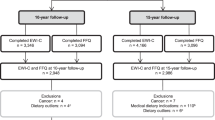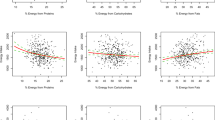Abstract
Background/Objectives:
Concerns of a growing obesity epidemic have increased since the association between obesity in parents and that in offspring was reported. However, the evidence regarding whether the energy-saving efficiency of obese parents is conveyed to their offspring and the duration of the expression of such transmitted efficiency is limited.
Subjects/Methods:
We included 7647 matching sets of parent–offspring trios from South Korea. Multiple linear regression models were performed to estimate the energy-saving efficiency, as assessed by the associations between energy intake and obesity-related indices (waist-to-height ratio, waist circumference and body mass index z-score), and to compare the energy-saving efficiency of offspring of obese and non-obese parents. All analyses were based on a complex sample design and were stratified by gender and age.
Results:
We identified a parental influence on obesity, that is, the more obese the parent, the higher the obesity-related indices of their offspring, in both genders and all age groups. The energy-saving efficiency of child offspring was highest when both parents were obese and lowest when both were non-obese; this difference was significant (P<0.05) with regard to the energy-saving efficiency of all types of intake studied, except fat. However, the energy-saving efficiency of obese and non-obese parents did not differ when their offspring were adolescents and adults.
Conclusions:
The critical window for transmission of energy-saving efficiency is limited to childhood. These findings suggest that children of obese parents should be more emphatically advised to maintain a balanced diet and to engage in regular physical activity.
This is a preview of subscription content, access via your institution
Access options
Subscribe to this journal
Receive 12 print issues and online access
$259.00 per year
only $21.58 per issue
Buy this article
- Purchase on Springer Link
- Instant access to full article PDF
Prices may be subject to local taxes which are calculated during checkout


Similar content being viewed by others
References
Finucane MM, Stevens GA, Cowan MJ, Danaei G, Lin JK, Paciorek CJ et al. National, regional, and global trends in body-mass index since 1980: systematic analysis of health examination surveys and epidemiological studies with 960 country-years and 9.1 million participants. Lancet 2011; 377: 557–567.
Ezzati M, Riboli E . Behavioral and dietary risk factors for noncommunicable diseases. N Engl J Med 2013; 369: 954–964.
Caballero B . The global epidemic of obesity: an overview. Epidemiol Rev 2007; 29: 1–5.
Garver WS, Newman SB, Gonzales-Pacheco DM, Castillo JJ, Jelinek D, Heidenreich RA et al. The genetics of childhood obesity and interaction with dietary macronutrients. Genes Nutr 2013; 8: 271–287.
de Onis M, Blössner M, Borghi E . Global prevalence and trends of overweight and obesity among preschool children. Am J Clin Nutr 2010; 92: 1257–1264.
Gillman MW, Ludwig DS . How early should obesity prevention start? N Engl J Med 2013; 369: 2173–2175.
Hill JO, Wyatt HR, Reed GW, Peters JC . Obesity and the environment: where do we go from here? Science 2003; 299: 853–855.
Neel JV . Diabetes mellitus: a "thrifty" genotype rendered detrimental by "progress"? Am J Hum Genet 1962; 14: 353–362.
Stöger R . The thrifty epigenotype: an acquired and heritable predisposition for obesity and diabetes? Bioessays 2008; 30: 156–166.
Diamond JM . Human evolution. Diabetes running wild. Nature 1992; 357: 362–363.
Hales CN, Barker DJP . Type 2 (non-insulin-dependent) diabetes mellitus: the thrifty phenotype hypothesis. Diabetologia 1992; 35: 595–601.
Gluckman PD, Hanson MA . Developmental and epigenetic pathways to obesity: an evolutionary-developmental perspective. Int J Obes 2008; 32: S62–S71.
Silverman BL, Cho NH, Rizzo TA, Metzger BE . Long-term effects of the intrauterine environment: The Northwestern University Diabetes in Pregnancy Center. Diabetes Care 1998; 21: B142–B149.
Abenhaim HA, Kinch RA, Morin L, Benjamin A, Usher R . Effect of prepregnancy body mass index categories on obstetrical and neonatal outcomes. Arch Gynecol Obstet 2007; 275: 39–43.
Taylor PD, Poston L . Developmental programming of obesity in mammals. Exp Physiol 2007; 92: 287–298.
Guo F, Jen KL . High-fat feeding during pregnancy and lactation affects offspring metabolism in rats. Physiol Behav 1995; 57: 681–686.
Kweon S, Kim Y, Jang MJ, Kim Y, Kim K, Choi S et al. Data resource profile: the Korea National Health and Nutrition Examination Survey (KNHANES). Int J Epidemiol 2014; 43: 69–77.
Korean Centers for Disease Control and Prevention, Ministry of Health & Welfare. An instruction for the fifth Korea National Health and Nutrition Examination Survey. 2011. Available from https://knhanes.cdc.go.kr/knhanes/index.do (accessed 30 October 2014).
Savva SC, Tornaritis M, Savva ME, Kourides Y, Panagi A, Silikiotou N et al. Waist circumference and waist-to-height ratio are better predictors of cardiovascular disease risk factors in children than body mass index. Int J Obes Relat Metab Disord 2000; 24: 1453–1458.
Ashwell M, Gunn P, Gibson S . Waist-to-height ratio is a better screening tool than waist circumference and BMI for adult cardiometabolic risk factors: systematic review and meta-analysis. Obes Rev 2012; 13: 275–286.
Heo M, Wylie-Rosett J, Pietrobelli A, Kabat GC, Rohan TE, Faith MS . US pediatric population-level associations of DXA-measured percentage of body fat with four BMI metrics with cutoffs. Int J Obes 2014; 38: 60–68.
Inokuchi M, Matsuo N, Takayama JI, Hasegawa T . BMI z-score is the optimal measure of annual adiposity change in elementary school children. Ann Hum Biol 2011; 38: 747–751.
Kim SH, Kim TH, Hwang HJ . The relationship of physical activity (PA) and walking with sarcopenia in Korean males aged 60 years and older using the fourth Korean National Health and Nutrition Examination Survey (KNHANES IV-2, 3), 2008–2009. Arch Gerontol Geriat 2013; 56: 472–477.
Forrestal SG . Energy intake misreporting among children and adolescents: a literature review. Matern Child Nutr 2011; 7: 112–127.
Kye S, Kwon SO, Lee SY, Lee J, Kim BH, Suh HJ et al. Under-reporting of energy intake from 24- hour dietary recalls in the Korean National Health and Nutrition Examination Survey. Osong Public Health Res Perspect 2014; 5: 85–91.
Cole TJ, Faith MS, Peitrobelli A, Heo M . What is the best measure of adiposity change in growing children: BMI, BMI %, BMI z-score or BMI centile? Eur J Cli Nutr 2005; 59: 419–425.
Lawlor DA, Lichtenstein P, Långström N . Association of maternal diabetes mellitus in pregnancy with offspring adiposity into early adulthood: sibling study in a prospective cohort of 280,866 men from 248,293 families. Circulation 2011; 123: 258–265.
Patel R, Martin RM, Kramer MS, Oken E, Bogdanovich N, Matush L et al. Familial associations of adiposity: findings from a cross-sectional study of 12,181 parental-offspring trios from Belarus. PLoS One 2011; 6: e14607.
Power C, Pouliou T, Li L, Cooper R, Hyppönen E . Parental and offspring adiposity associations: insights from the 1958 British birth cohort. Ann Hum Biol 2011; 38: 390–399.
Franks PW, Hanson RL, Knowler WC, Sievers ML, Bennett PH, Looker HC . Childhood obesity, other cardiovascular risk factors, and premature death. N Engl J Med 2010; 362: 485–493.
Reilly JJ, Kelly J . Long-term impact of overweight and obesity in childhood and adolescence on morbidity and premature mortality in adulthood: systematic review. Int J Obes 2011; 35: 891–898.
Fox CS, Pencina MJ, Heard-Costa NL, Shrader P, Jaquish C, O’Donnell CJ et al. Trends in the association of parental history of obesity over 60 years. Obesity 2014; 22: 919–924.
Cooper R, Pinto Pereira SM, Power C, Hyppönen E . Parental obesity and risk factors for cardiovascular disease among their offspring in mid-life: findings from the 1958 British Birth Cohort Study. Int J Obes 2013; 37: 1590–1596.
Lieb W, Pencina MJ, Lanier KJ, Tofler GH, Levy D, Fox CS et al. Association of parental obesity with concentrations of select systemic biomarkers in nonobese offspring: the Framingham Heart Study. Diabetes 2009; 58: 134–137.
Bayol SA, Simbi BH, Bertrand JA, Stickland NC . Offspring from mothers fed a ‘junk food’ diet in pregnancy and lactation exhibit exacerbated adiposity that is more pronounced in females. J Physiol 2008; 586: 3219–3230.
Acknowledgements
This study was supported by the Ministry of Environment as an Environmental Health Center Program. We thank the KNHANES 2007–2011 participants and investigators as well as the Korea Centers for Disease Control and Prevention for making the public data available.
Author information
Authors and Affiliations
Corresponding author
Ethics declarations
Competing interests
The authors declare no conflict of interest.
Additional information
Supplementary Information accompanies this paper on European Journal of Clinical Nutrition website
Supplementary information
Rights and permissions
About this article
Cite this article
Kim, Y., Kim, H. & Hong, YC. Transmission of energy-saving efficiency from obese parents to their offspring: the Korean National Health and Nutrition Examination Survey 2007–2011. Eur J Clin Nutr 70, 511–516 (2016). https://doi.org/10.1038/ejcn.2015.172
Received:
Revised:
Accepted:
Published:
Issue Date:
DOI: https://doi.org/10.1038/ejcn.2015.172



